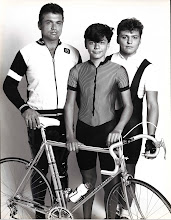At the US Masi factory in Carlsbad, Mario oversaw production of some 2,200 bicycles over the course of three years. To reach that level of production, Mario was required to train a number of Mexican workers. They were hired to do the majority of the preparation work that goes into building a frame.
Mario's widowed wife, then girlfriend, Lisa recalls, "Mario respected the Mexican guys who helped him. They would often have lunch together, Mario enjoyed the tortillas. These men would come up from Mexico and make a sacrifice to take care of their families, send home every penny. These were the people that Mario admired, people who worked hard and took care of their families. He was so Old World."
However, when it came to building and marketing bicycles Mario anything but "Old World". In an effort to conquer the US bicycle market, Faliero Masi and Mario went to the Encino velodrome one evening. The reigning sprinter of the 70's, Jerry Ash was at the track working out. He was offered a Masi track frame.
Ash recounts, "Before I received the Masi, I was riding a Rickerts and before that, a Paramount. I went to the Masi factory at Carlsbad and I was measured for the frame which Mario then built. I wanted an all-around track frame that would be good for sprinting. The ride of the bike was tremendous."
Custom Bicycles by Confente was located in Los Angeles. One of the first things Mario did was contact Jerry Ash and offer to build him a road and track bike. Ash went on to ride the Confente track frame in the World Championships in 1976, 77, and 78. In 1977, he finished seventh in the match sprints, the highest finish for an American in over a decade. Before long, other top riders, including Jonathan Boyer, were traveling to Los Angeles for a Confente frame.
Lisa recalls that Mario poured his heart and soul into this new venture. "He worked like a fiend. I would have to tear him out of the place in LA. He would not leave until it was spotless clean. I would help him sweep the floor - anything to get him out of there!"
Confente frames were the rage at the New York bicycle show the first year that they were unveiled. Tom Kellogg, of Spectrum Cycles, recalls, "Mario made beautiful stuff and he pushed the American builders beyond a look that we all had, which was kind of simple, plain lines. He forced us to class up our act. Mario's frames were the first to combine American quality and the Italian look. That had never been done before. Fairly rapidly after that the Americans made their frames look slicker."
Ben Serotta adds, "After seeing Confente's bikes at the New York show, it was clear that he raised the standard." Richard Sachs recalls looking at the Confente brochure and shaking his head in disbelief that someone could charge $400 for a custom frame. At the time, Sachs was charging $180 for a custom frame. Sachs notes, "I remember asking myself, what could a builder possible do to a frame to make it cost so much more?"
As beautiful and skillfully made as the Confente frames were, they were also expensive. Recht decided to capitalize on Mario's name and innovations. Unbeknownst to Mario, Recht was preparing to launch another, less expensive bicycle frame. When Mario ordered 100 dropouts for the Confente bicycles, Recht ordered 200. The Medici frame was to be unveiled at the next New York bicycle show. Prior to the show, Confente learned that his name was going to be used to launch this new frame. He perceived the Medici frame to be an inferior product. He promptly handed in a letter of resignation and was immediately locked out of the factory. Unable to retrieve his tools, Confente headed north to the one place where he knew he could continue to build frames, Monterey.
Mario had traveled to Monterey previously to meet with Boyer and a sponsor of Boyer's, George Farrier. Farrier had a machine shop in his garage and Confente was impressed by the size of the shop. In the year that followed, he worked without distraction. Farrier recalls the day Mario showed up at his property, "Mario pulled into the driveway in his car. I was surprised to see him. I asked him what he was doing here and in his thick Italian accent he said that he was here to build bicycles."
While Farrier's accommodations were first class, Mario still longed for his own shop. He and Jim Cunningham put together a business plan. In addition to developments in his career, Mario's personal life was taking a new step forward. Mario proposed to his longtime girlfriend and the two were married shortly thereafter.



No comments:
Post a Comment